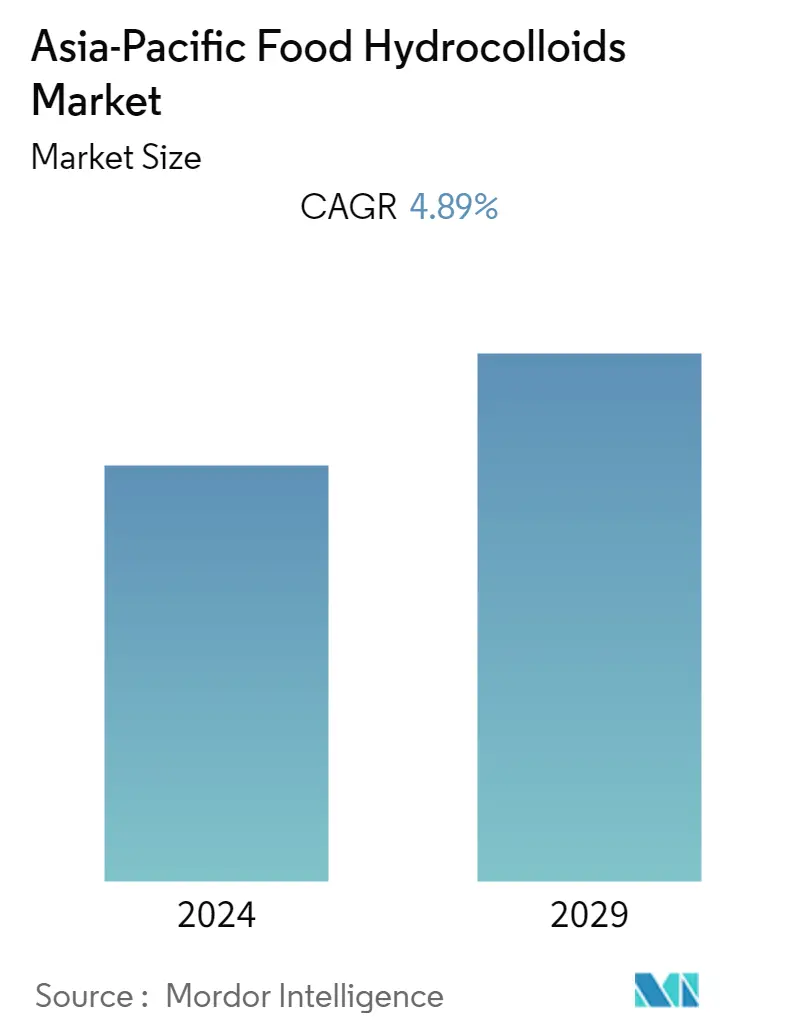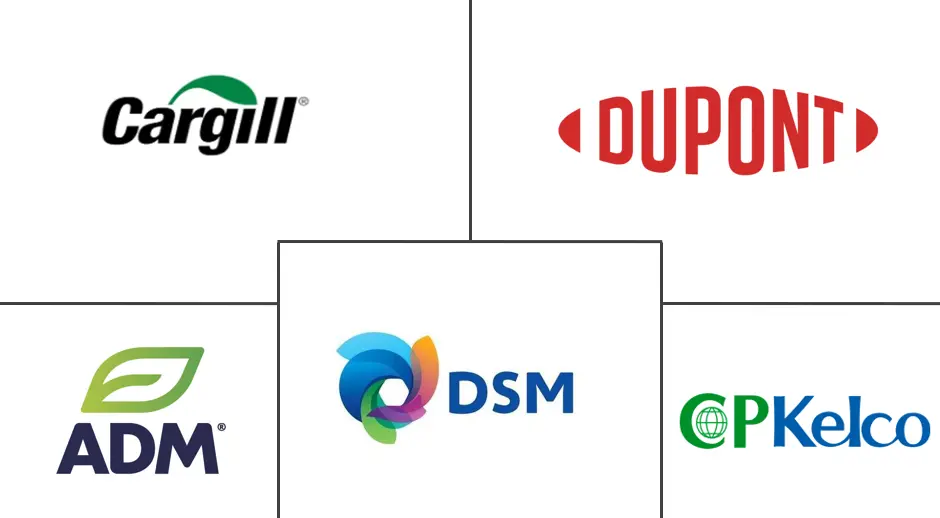Market Size of Asia-Pacific Food Hydrocolloids Industry

| Study Period | 2019 - 2029 |
| Base Year For Estimation | 2023 |
| Forecast Data Period | 2024 - 2029 |
| Historical Data Period | 2019 - 2022 |
| CAGR | 4.89 % |
| Market Concentration | Low |
Major Players
*Disclaimer: Major Players sorted in no particular order |
Asia-Pacific Food Hydrocolloids Market Analysis
Asia-Pacific food hydrocolloids market is projected to grow at a CAGR of 4.89% during the forecast period (2020-2025).
- Consumer preference for natural ingredients and the varied applications of hydrocolloids in the food and beverage industry are some of the reasons for the uptick in demand. The changing consumer demographics in terms of lifestyle changes and growing working population, resulting in consumer demand for convenience and processed food, especially among the emerging nations, is an opportunity for manufacturers to adopt hydrocolloids in the region.
- Furthermore, key players in the market are continuously focused on R&D to provide innovative products to cater to their growing demand in processed & convenience foods.
- However, the market is mainly constrained by demand and supply imbalances. Seasonal changes cause volatility in raw material pricing, thus raising costs for manufacturers. Despite restrains, the market sees huge potential for growth in Asia-Pacific region,.
Asia-Pacific Food Hydrocolloids Industry Segmentation
The Asia-Pacific food hydrocolloids market is segmented by type, application, and geography. Based on type, the market has been further segmented into gelatin gum, pectin, xanthan gum, and other types, while based on application, it has been segmented into dairy and frozen products, bakery and confectionery, beverages, meat and seafood products, oils and fats, and other applications. By geography, the market is segmented under China, Japan, India, Australia, and Rest of Asia-Pacific.
| By Type | |
| Gelatin Gum | |
| Pectin | |
| Xanthan Gum | |
| Other Types |
| By Application | |
| Dairy and Frozen Products | |
| Bakery and Confectionery | |
| Beverages | |
| Meat and Seafood Products | |
| Oils and Fats | |
| Other Applications |
| By Geography | |
| China | |
| Japan | |
| India | |
| Austalia | |
| Rest of Asia-Pacific |
Asia-Pacific Food Hydrocolloids Market Size Summary
The Asia-Pacific food hydrocolloids market is experiencing a notable expansion, driven by a growing consumer preference for natural ingredients and the diverse applications of hydrocolloids within the food and beverage sector. This growth is particularly evident in emerging nations, where shifts in consumer demographics, such as lifestyle changes and an increasing working population, are fueling demand for convenience and processed foods. Manufacturers are seizing this opportunity to incorporate hydrocolloids into their products, supported by ongoing research and development efforts aimed at delivering innovative solutions. Despite challenges such as demand and supply imbalances and fluctuating raw material costs due to seasonal changes, the market holds significant growth potential across the region.
In the beverage sector, hydrocolloids are extensively used in products like acidified protein drinks, alternative milk, and carbonated soft drinks, with gellan gum, xanthan, and pectin being particularly popular. The fast-growing populations in countries like India and other Southeast Asian nations are driving demand for soft drinks, further propelling market growth. China and India are leading the market, with increasing awareness of nutritional food and changing consumer lifestyles contributing to the demand for hydrocolloids. Meanwhile, Japan's market is expanding due to the rising demand for convenience food, and Australian consumers are increasingly seeking natural additives. However, the supply chain faces challenges in countries like Indonesia and Thailand, where unseasonal changes affect the availability of seaweed extracts, a key raw material. Overall, the Asia-Pacific region is poised for significant growth in the food hydrocolloids market during the forecast period.
Asia-Pacific Food Hydrocolloids Market Size - Table of Contents
-
1. MARKET DYNAMICS
-
1.1 Market Drivers
-
1.2 Market Restraints
-
1.3 Porter's Five Force Analysis
-
1.3.1 Threat of New Entrants
-
1.3.2 Bargaining Power of Buyers/Consumers
-
1.3.3 Bargaining Power of Suppliers
-
1.3.4 Threat of Substitute Products
-
1.3.5 Intensity of Competitive Rivalry
-
-
-
2. MARKET SEGMENTATION
-
2.1 By Type
-
2.1.1 Gelatin Gum
-
2.1.2 Pectin
-
2.1.3 Xanthan Gum
-
2.1.4 Other Types
-
-
2.2 By Application
-
2.2.1 Dairy and Frozen Products
-
2.2.2 Bakery and Confectionery
-
2.2.3 Beverages
-
2.2.4 Meat and Seafood Products
-
2.2.5 Oils and Fats
-
2.2.6 Other Applications
-
-
2.3 By Geography
-
2.3.1 China
-
2.3.2 Japan
-
2.3.3 India
-
2.3.4 Austalia
-
2.3.5 Rest of Asia-Pacific
-
-
Asia-Pacific Food Hydrocolloids Market Size FAQs
What is the current Asia-Pacific Food Hydrocolloids Market size?
The Asia-Pacific Food Hydrocolloids Market is projected to register a CAGR of 4.89% during the forecast period (2024-2029)
Who are the key players in Asia-Pacific Food Hydrocolloids Market?
Cargill, Incorporated, Koninklijke DSM N.V., Cp Kelco, Archer Daniels Midland Company and DuPont de Nemours, Inc. are the major companies operating in the Asia-Pacific Food Hydrocolloids Market.

